Sports
Thirty years ago, Hideo Nomo's bold gambit paved the way for Ichiro, Ohtani to thrive
When Hideo Nomo debuted for the Los Angeles Dodgers on May 2, 1995, he was only the second Japanese-born player to appear in the majors, and the first in 30 years. The maneuvering needed to reach that moment had already made Nomo a groundbreaker, pitting the player and his agent, Don Nomura, against Japan’s baseball […]


When Hideo Nomo debuted for the Los Angeles Dodgers on May 2, 1995, he was only the second Japanese-born player to appear in the majors, and the first in 30 years.
The maneuvering needed to reach that moment had already made Nomo a groundbreaker, pitting the player and his agent, Don Nomura, against Japan’s baseball establishment. To get to America, Nomo and Nomura had to figure out how Nomo could escape his contract back home.
Advertisement
No one foresaw the media storm that would follow: Nomo-mania. The righthander was a rookie marvel, commanding the attention of two countries with a split-finger fastball. Nomo was nicknamed “The Tornado” for his wind-up, which began with him stretching his arms to the sky, followed by a twist clockwise until his chest was almost square to second base.
Major League Baseball needed him. In 1995, the league was emerging from one of its darkest winters. The World Series had just been canceled as part of a player strike, and the upcoming season was still in limbo.
Today, Shohei Ohtani is the best player on Earth. Ichiro Suzuki’s enshrinement in the Hall of Fame is coming this summer. But entering 1995, the only Japanese player in MLB history was Masanori Murakami, who pitched in 54 games for the San Francisco Giants from 1964-65.
“The arrival of Ohtani, which in itself is just unbelievable, makes me, or anyone — you, somebody — reflect, ‘Well, how the heck did this get started?’” said Peter O’Malley, owner of the Dodgers when they signed Nomo for $2 million in 1995. “I think Ohtani’s performance has brought back Hideo, has brought back that time.”
The Athletic interviewed 17 people to remember Nomo-mania 30 years on. A typically quiet person, Nomo declined to be interviewed when reached through the San Diego Padres, for whom he is an advisor and instructor.
Interviews have been condensed and edited for clarity. Titles are as of 1995.
Nomo debuted in Japan’s top league, Nippon Professional Baseball, in 1990 and struck out 287 batters. He fanned that exact number again the following year. But by 1994, he was hurt, and he wanted out.
Help awaited in Northern California, where Don Nomura owned a minor-league baseball team. Nomura had played in the minors in Japan, and was the stepson of a great Japanese player, Katsuya Nomura.
Nomura believed Japanese players should push for change.
Advertisement
Don Nomura: We had a mutual friend, Tsuneto Fukuchi, who pitched for the Kintetsu Buffaloes.
One day he calls me. He says, “I have a player, he wants to go to the States. Can you talk to him?’’ And it was Hideo. That’s May of ’94.
I said, “You have to wait 10 years, because that’s that’s the rule right now,” and he says, “I can’t wait 10 years.”
Eiji Yamazaki, Kyodo News reporter covering Nomo: The manager of the Kintetsu Buffaloes when Nomo was a member was a famous left-handed pitcher, and he was confident in his own way of pitching, and seemed to insist on Nomo doing it as well. Nomo’s pitching form was distinctive and unconventional, even in Japan.
Nomura: One game he pitched, they were winning 11-2, he’s going nine innings with 172 pitches. And he got hurt. The manager basically said, “You don’t have the guts to throw.” Different age, different era.
Mark Langill, Dodgers publications editor (and now historian): If Nomo has a manager that caters to him? Maybe this never happens.
Nomura: I said, “I know you can’t wait 10 years, you’ll probably be done in three, if that.” Hideo did not like the way he was managed.

Hideo Nomo’s twisting, “Tornado” windup stood out wherever he pitched. (Simon Barnett / Getty Images)
Jean Afterman, lawyer working with Nomura: Don took me to a Yomiuri Giants game. I asked Don, “How come there aren’t more Japanese players playing in the major leagues?”
Don turned to me and said, “Well, I’m glad you asked.” And Don then told me that there was an agreement between the U.S. commissioner and Japanese Commissioner that effectively prevented Japanese players from coming to the United States.
Nomura: There was basically no path.
Yamazaki: In those days in Japanese baseball, players being traded or leaving a team was seen as negative. It was not uncommon for players who wanted to go to another team to be called selfish and self-centered.
Nomura: I went through the U.S.-Japan agreement back then. The U.S. team cannot sign players that were on the active list and restricted list, but didn’t say anything about the players on the retirement list. So the question became, “Wow, so if you retire in Japan, you can play in the United States?”
Advertisement
Afterman: We didn’t know at the time that this was going to be an effective loophole. If you’re the mouse that roared, the other side can take its enormous paw and swat you down.
The stakes were high enough that Nomura, over a period of a few months, sought and received three separate confirmations that the loophole was viable. First, he took a tape recorder to a meeting at NPB’s office. Then he had a friend with the Seattle Mariners, Lee Pelekoudas, pose the question through MLB. Lastly, he asked his mentor, agent Arn Tellem, to inquire in writing. The answers were consistent: A retired NPB player could play in MLB.
Arn Tellem, player agent: We sat in my office in Santa Monica, overlooking the ocean in a conference room. There was this mutual “aha” moment, that there was an opportunity there.
Nomura: The next question is, how do we get Nomo retired?
When trying to pressure players, NPB teams would threaten them with placement on the voluntarily retired list. Most players would fear the idea. Nomura and Nomo wanted nothing more.
Nomura: There were no multiyear contracts back then in Japan. I told him, “Let’s go with a multiyear deal.” And I think we came up with a figure of six years, $36 million. He was making about $1.5 million then as the best pitcher in Japan. I said, “If they guarantee you the next six years, stay with the Japanese team, because that’s a lot of money.”
We went for our first meeting. I walked in with Hideo into the hotel room in Osaka, and Mr. Yasuo Maeda, the then-president, just said, “Nomura, Get out of the room. We don’t recognize you.” I said, “I’m his agent.” He said, “We don’t need agents.” Then he grabs Hideo’s arm, and he says, “You stay here.”
Afterman: I always call it, not elegantly: Hideo had the balls of a lion. Hideo was strong and courageous.
Advertisement
Nomura: Hideo slips his arm out and says, “No, I’m leaving too.” And then I said, “Hideo, why don’t you stay? We came all the way from Tokyo.”
About 15 minutes later, Nomo comes out. He said, “They’re really pissed.”
Bobby Valentine, newly named manager of the Chiba Lotte Marines: The rumors started to appear. At a sushi dinner, I remember hearing as though it’s a secret, that Kintetsu was rejecting the idea of a long-term contract.
Nomura: The next meeting took place Dec. 19 or 20th in Osaka. We kept saying, “Six years, $36 million.” Finally, Maeda, the president, told Nomo, “Sign this contract or we’re gonna make you into a voluntarily retired player,” and that was the word we were waiting for.
I was waiting in the lobby, Hideo comes running out of the elevator, he says, “We did it.”
Valentine: Most of the baseball community in Japan thought of Nomo as a traitor. They didn’t like the concept.
Nomura: With all the negative media, and all the crap I got from the media and people in Japan wanting to kill me — called a traitor, and everything else, I didn’t have any time to think it was a genius idea.
Word got out in the U.S. in mid-January 1995 that Nomo wanted to come to MLB as a free agent. In the U.S., Nomo was mostly unknown.
Fred Claire, Dodgers general manager: I received a phone call from the agent Arn Tellem: “Fred, I’ve gotten a call from a fellow by the name of Don Nomura. Do you have any interest in signing Hideo Nomo?”
I said, “Arn, I have to be honest with you, I have no idea in the world who in the hell Hideo Nomo is.”
Acey Kohrogi, Dodgers official: I was helping Dodgers owner Peter O’Malley with Japan affairs. I said, “OK, let’s call some of our friends in Japan.”
Nomo set out to visit several teams. The first stop was Seattle. Next was San Francisco, then L.A., and after that, New York for the Yankees.
Advertisement
Nomura: Seattle helped me so we gave them the first shot. They had him do a physical. He failed the physical.
Dodgers owner Peter O’Malley: I had never heard that, ever.
Nomura: We were really welcomed. We went to the Kingdome, Jay Buhner and all those guys were out there: Edgar Martínez greeted us.
Seattle came back and said, “We can’t give him anything significant. We don’t like what we saw on the MRI of his shoulder.” Seattle was certainly on top of the list.
Lee Pelekoudas, Mariners executive: We had some concern. Obviously, it was misplaced!
Nomura: We had a good meeting the following day at Candlestick Park, they offered us a major-league contract, two years, fairly low, lower than what he was making in Japan. We said we’ll think about it.
We didn’t want to cross the line because baseball was in a strike. If Nomo was going to sign a major-league contract, it would have been either wait, or have a letter of agreement.
Then we went down to Los Angeles.
The Dodgers had a rich history with Japan, from ownership down to manager Tommy Lasorda. O’Malley, who first visited the country with the 1956 Dodgers, knew the stakes for Nomo would be high, and that criticism in Japan could follow.
O’Malley: I said to myself, “Wait a minute, is this going to put the Dodgers negatively in the mind of the fans? Is this going to be detrimental?” I had a meeting with myself.
I said, “No, you know what, if we present this accurately, honestly, that he wants to face the best hitters, that’s his challenge, and he’s heard they’re in the United States, I think the fans will accept that. Not all, but most.”
Derrick Hall, Dodgers public relations: Peter O’Malley said, “If we get him, your job is going to get very interesting.”
O’Malley: I told the people in my office, “I don’t want to talk contract. I don’t want to talk money. Don’t bring it up.” I wanted him to tell me about himself, and I wanted him to know more about me.
Advertisement
Now the meeting’s been maybe 90 minutes, and I said, “I’d like to see you tomorrow,” and I knew they were leaving to go to New York. They look at each other, they’re talking in Japanese.
Nomura: Everything stopped with the Dodgers. He did not meet with any other club, or talk to any other club.
O’Malley: Don says, “Yes, we can come back tomorrow.”
Tellem: It became clear that the Dodgers, putting aside money, were the best fit. The Dodgers probably have the most unique history of championing diversity, starting with Jackie Robinson. Given Los Angeles’ large Japanese population, this was the right place.
Claire: I remember meeting in my office, and Don Nomura said, “What we really want is a major-league contract.” I said to him, “Major-league contracts are to be earned and not given. And I want you to explain that to Hideo.”
Hideo kind of shook his head in an understanding way, and Don came back and said, “Then the one thing that he’s asking is, will he be given an opportunity to make the club in the spring?”
And I said, “Don, without question, we will give him every opportunity.” It was a $2 million bonus, which in today’s world seems like a typo.

Peter O’Malley shakes Hideo Nomo’s hand after officially signing him to a minor-league contract, while Don Nomura, at left, looks on. (J.D. Cuban / Getty Images)
The signing garnered attention everywhere.
Gene Orza, a top lawyer at the MLB players’ union: Major League Baseball has always been sensitive to honoring the Japanese reserve clauses, because of a fear that if we didn’t honor theirs, they wouldn’t honor ours, and they would poach. Some people were afraid this was going to open up the floodgates, so to speak.
Tom Candiotti, Dodgers starting pitcher: All eyes are on him when he gets to spring training. Everything he does, there’s cameras on him. We really didn’t quite know the big deal he was in Japan.
Hall: He came to Dodgertown, and I’ve got this huge group of Japanese media that have been waiting for his arrival. He comes in this minivan, and they all start chasing after him. He had his driver just going around in circles at Dodgertown until they just all dropped off, they could no longer run.
Advertisement
Yamazaki: Including newspaper, television, and camera crews, I think there were always around 15 to 20 people.
Bob Nightengale, Dodgers beat writer for the LA Times: It was crazy. Not like Ohtani, not that big, but it was big: covering one player, watching every single bullpen session.
Hall: We were playing the Yankees in Fort Lauderdale, and their PR person came over and said, “The boss wants to see you.” I had never met George Steinbrenner. He takes me over to his box, and George points down and says, “Who is this guy and where’d you get him from?”
The strike ended in early April, delaying the start of the season. Nomo made his minor-league debut on April 27, 1995. He was in the big leagues a week later, and threw five shutout innings against the Dodgers’ biggest rival, the San Francisco Giants.
Nightengale: Is this guy gonna do well, is it just a flash-in-the-pan type thing, novelty act? Nobody had an idea among the writers.
Candiotti: I just remember saying through his interpreter before his first start, “There’s a lot of nerves and everything, just go out and do your best.” And then I go, “And don’t f— up.” He just started laughing.
I happened to get along great with him. We’d sit on the bench, and he knew enough words, and he was teaching us enough Japanese words that we could kind of communicate.
Yamazaki: I remember him being a very shy person, and with the exception of a few close reporters, there was an awkward atmosphere when he interacted with the media. He didn’t say much.
Candiotti: These guys and their cameras, they followed him everywhere, he was like a rock star.
Dodgers first baseman Eric Karros: Flashes would go off every time he’d pitch. There were times where there would be media that would follow him into the bathroom.

A large media contingent chronicled Hideo Nomo’s every move. (Rhona Wise / AFP via Getty Images)
June, his second month, is when Nomo really took off. In his ninth career big-league start, he struck out 16. That began a six-start stretch where he compiled a 0.89 ERA and 70 strikeouts in 50 1/3 innings.
Langill: You’re starting to compare him to Sandy Koufax records, because he had like, 50 strikeouts in a four-game span. I don’t think that Dodger fans in L.A. realized what pressure he was under.
Advertisement
O’Malley: He was very serious. The fact that he was the first after Murakami, you bet he carried that, and that’s why I admire him even more. Because the spotlight, the focus on him, was extraordinary. Chan Ho Park went through pretty much the same thing with the Korean community.
Yamazaki: It was interesting to see how the reactions of the American media and fans were different from those in Japan. American society is not negative about people moving around. If anything, it tends to be viewed as positive.
Kohrogi: Mr. O’Malley used to always tell me back then, “I’ve never seen a player that has that much focus, with all the noise.” A whole country is watching the guy pitch, and it doesn’t even faze him. You’d see Japanese businessmen watching Nomo pitch on the street corners, because it was on a big monitor on the side of the building.
Candiotti: I think they started bringing Yoshinoya into Dodger Stadium instead of Taco Bell. They were sending like, 747s over from Japan on the days he pitched.
Kohrogi: You have people flying from Tokyo just to watch him pitch and flying back. Japanese tourists coming in, leaving with bags of Nomo t-shirts.
Candiotti: He’s pitching. I follow him in after the first inning and he’s taking his jersey off. I’m like, “OK, that’s weird.” Pitches the second inning, comes back in, changes his jersey again. And I’m going, “What the f—?”
So I asked Dave Wright, who was the clubhouse manager at the time. He told me that every one of Nomo’s game-used jerseys that he pitches in, he gets $50,000 a jersey in Japan.
Afterman: The worst marketing request we had was a company that wanted a drop of Hideo’s blood because they were making pendants, and they purported to have a tiny bit of DNA from famous people in them. Don and I looked at each other like, “Oh, hell no.”
On July 11, 1995, the rookie Nomo started in the All-Star Game for the National League in Texas. He threw two scoreless innings, allowing one hit and striking out three.
Advertisement
Robert Whiting, author of “You Gotta Have Wa”: A Japanese TV announcer outside the stadium pregame faced the camera and said breathlessly, “Can you believe it? Can you believe it? A Japanese player is starting the All-Star Game.”
Valentine: I was in Tokyo during that All-Star Game. I saw the big screen set up in public squares. By then, it was people changing their story, getting behind him, kind of pulling for him.
Nomura: I haven’t forgiven the Japanese media, and I don’t think he has.

Nomomania ratcheted up ahead of his All-Star Game appearance. (Yoshikazu Tsuno / AFP via Getty Images)
Nomo was named the National League Rookie of the Year in 1995, and Nomo-mania rolled into the ’96 season. Late that season, he threw a no-hitter at the best hitter’s park in the majors, Coors Field.
Nomo stayed with the Dodgers into 1998, when he was traded to the New York Mets. More Japanese players followed in his footsteps and came to MLB in the late 1990s, including Shigetoshi Hasegawa, Hideki Irabu and Masato Yoshii. Ichiro Suzuki arrived in 2001, the same year that Nomo, then with the Boston Red Sox, threw his second no-hitter.
Nomura: The success that they had in Major League Baseball created more abundance of Japanese players, but it was still tough to bring any of them over.
Afterman: Players in Japan were not permitted to have agents. We were going to meet a player in Tokyo. As a former actress, it was just so much fun to me: I would wear a fake wig, I would get in a taxi cab. I’d drive around Tokyo to make sure nobody was following. I’d go into an underground parking lot. There would be a car waiting to drive me somewhere else. It was cloak-and-dagger stuff.
Yamazaki: What Nomo and Don Nomura did, there is no doubt that it marked a turning point in the history of Japanese professional baseball.
Orza: The three most important people in the history of baseball: Babe Ruth, Jackie Robinson and Marvin Miller. But if I had to name a fourth guy, it might be Nomo. He opened up the floodgates. He made America respect Japanese baseball more, because he was so successful.
Advertisement
Tellem: You needed one trailblazer, and that was Nomo. It changed my entire outlook of how I was going to be an agent. I was going to make it a priority to expand my practice globally.
Hideki Okuda, Sports Nippon reporter: I place him on the same level as Ichiro and Ohtani. Although he rarely appears in the media, many people are grateful to him and respect him as someone who contributed significantly to the development of Japanese sports culture.
If MLB continues to emphasize the importance of globalization, I believe it should show greater respect for Nomo, the pioneer who started it all.
MLB’s regular season opened this year in Tokyo, between the Dodgers and Chicago Cubs. Nomo was asked to throw out a ceremonial first pitch.
O’Malley: We had lunch, and he said, “Well, I told them no.”
He’s very modest. Whatever the definition of braggart is, he is the opposite. With his youth teams, he devotes an awful lot of time. He wants to give back, that’s his expression, to the kids who were overlooked.
He wants to do what he wants to do.
Valentine: It is remarkable what he did, and he should be in the Hall of Fame for it. It took courage, but it wasn’t only courage — as though he already was in the car, and to drive it 160 miles an hour took courage. He had to build the car.
(Illustration: Will Tullos / The Athletic; Photos: J.D. Cuban, Owen C. Shaw, Al Bello, Dan Groshong / Getty Images)
Sports
Mavericks volleyball showed resilience in wake of levy failure
MOSES LAKE – When the Moses Lake School District 2024 educational programs and operations levy failed for the first time, coaches like Mavericks volleyball coach Krystal Trammell were unsure what would happen if it failed a second time. What they were certain about was their dedication to the kids at Moses Lake High School. […]

MOSES LAKE – When the Moses Lake School District 2024 educational programs and operations levy failed for the first time, coaches like Mavericks volleyball coach Krystal Trammell were unsure what would happen if it failed a second time. What they were certain about was their dedication to the kids at Moses Lake High School.
“I don’t think there was one coach or one program that wasn’t in to do it for the kids,” Trammell said. “We knew exactly what we needed to do. We just didn’t know how to go about it, how the teams were going to look, our transportation equipment, etcetera. But relying on each other really helped things kind of materialize.”
After the levy failed a second time, Trammell knew it was real and had to figure out how the team was going to have a volleyball season. She said the hard work of the coaches at Moses Lake and the Community Athletics and Activities booster helped the season come to fruition.
Trammell said parents stepped up and helped organize transportation for the athletes to get to games and tournaments throughout the fall season. When they had to figure out how to have a season, it was clear that their culture was in jeopardy, according to Trammell. Over the years, she said they have worked hard to build a culture of students first, athletes second.
“When that opportunity could have been taken from us, we turned to each other, our parents, our coaching staff and our athletes, and came together as a group stronger than before. We were going to do everything in our power to make the program even better and get more hands involved. That’s exactly what happened with our parents and athletes and coaches,” Trammell said.
The Mavericks volleyball team managed to put together one of their best seasons in a long time, according to Trammell. They finished the season with a 12-6 record and secured a highlight 3-1 win over West Valley, which Trammell said was their first in program history. Trammell could see something shifted in her players’ last season that made a difference.
“Program-wide, the girls had something to prove. They were not going to let the levy failure and the fact that we almost didn’t have a season ruin anything. I think they came out more on fire to show everyone ‘no, we’re not going to stop, and this is what we’re going to do,’” she said.
Trammell said her team excelled with court awareness, mental toughness and utilizing everything they have worked on over the last couple of years. She said she liked what she saw from her team last season, and it makes her excited for this upcoming season since they will have nine returning players. She said they will benefit from coming in with more knowledge and experience.
However, now that a new levy was passed this year, they will still have another season without a budget until January 2026. Though Trammell said it will be business as usual heading into the season. She said their experience last season will help them navigate this season more effectively as they learn more throughout the summer.
According to Trammell, she is confident they will have another season after seeing all of the support they got last year. She is confident in her community, she said, and believes in Mavericks athletics. In the meantime, Trammell plans to prepare for the fall season the same way she always does.
“We’re just concentrating on the workouts and our summer league and preparing for the season, and we’ve been through it once, and so going through it again, it won’t be as difficult this time,” she said. “It brought all the coaches together and I think sportsmanship is different. I just think everyone came together as a whole league instead of just one community, one town, one school.”
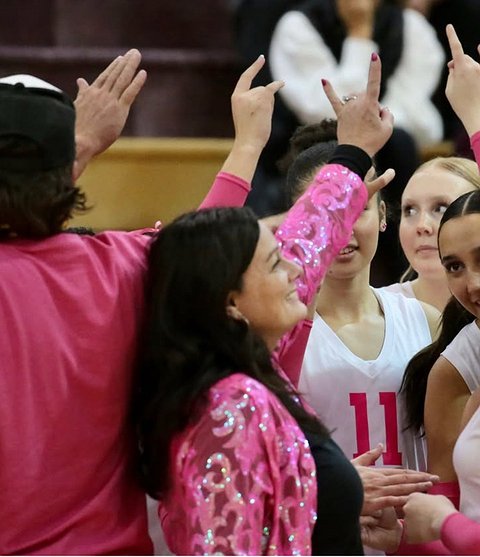 Krystal Trammell breaks down a huddle with her players before a game. Trammell said her players played with something to prove this season in the wake of the 2024 levy failure.
Krystal Trammell breaks down a huddle with her players before a game. Trammell said her players played with something to prove this season in the wake of the 2024 levy failure.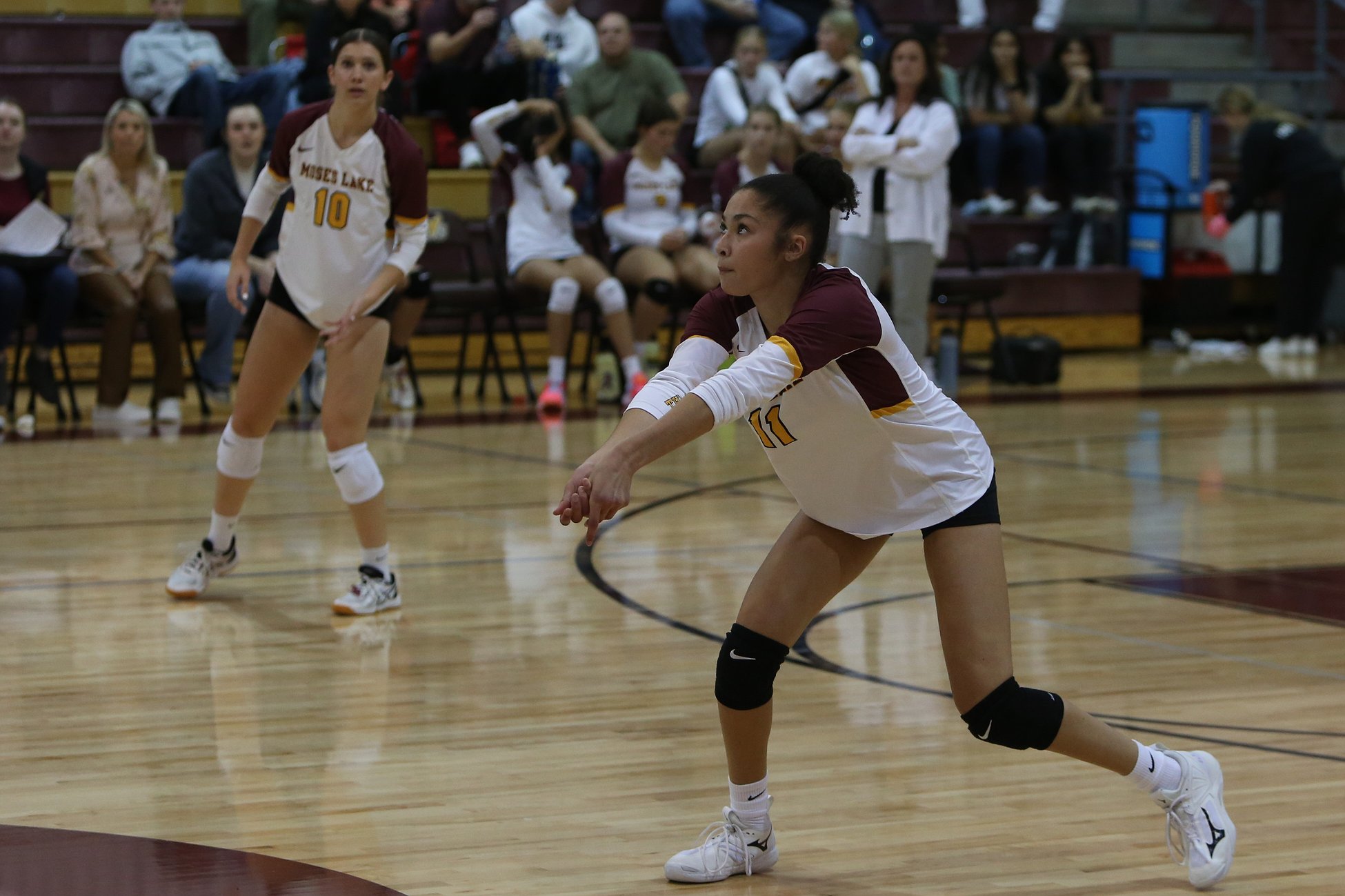 Mavericks Maddy Bond prepares for an incoming ball during a set. Bond made the All-League first team in the Big Nine conference.
Mavericks Maddy Bond prepares for an incoming ball during a set. Bond made the All-League first team in the Big Nine conference. The Mavericks’ Makenna Stuart serving the ball in their game against Sunnyside last season. Stuart was an honorable mention in the Big Nine All-League team announcements last Fall.
The Mavericks’ Makenna Stuart serving the ball in their game against Sunnyside last season. Stuart was an honorable mention in the Big Nine All-League team announcements last Fall.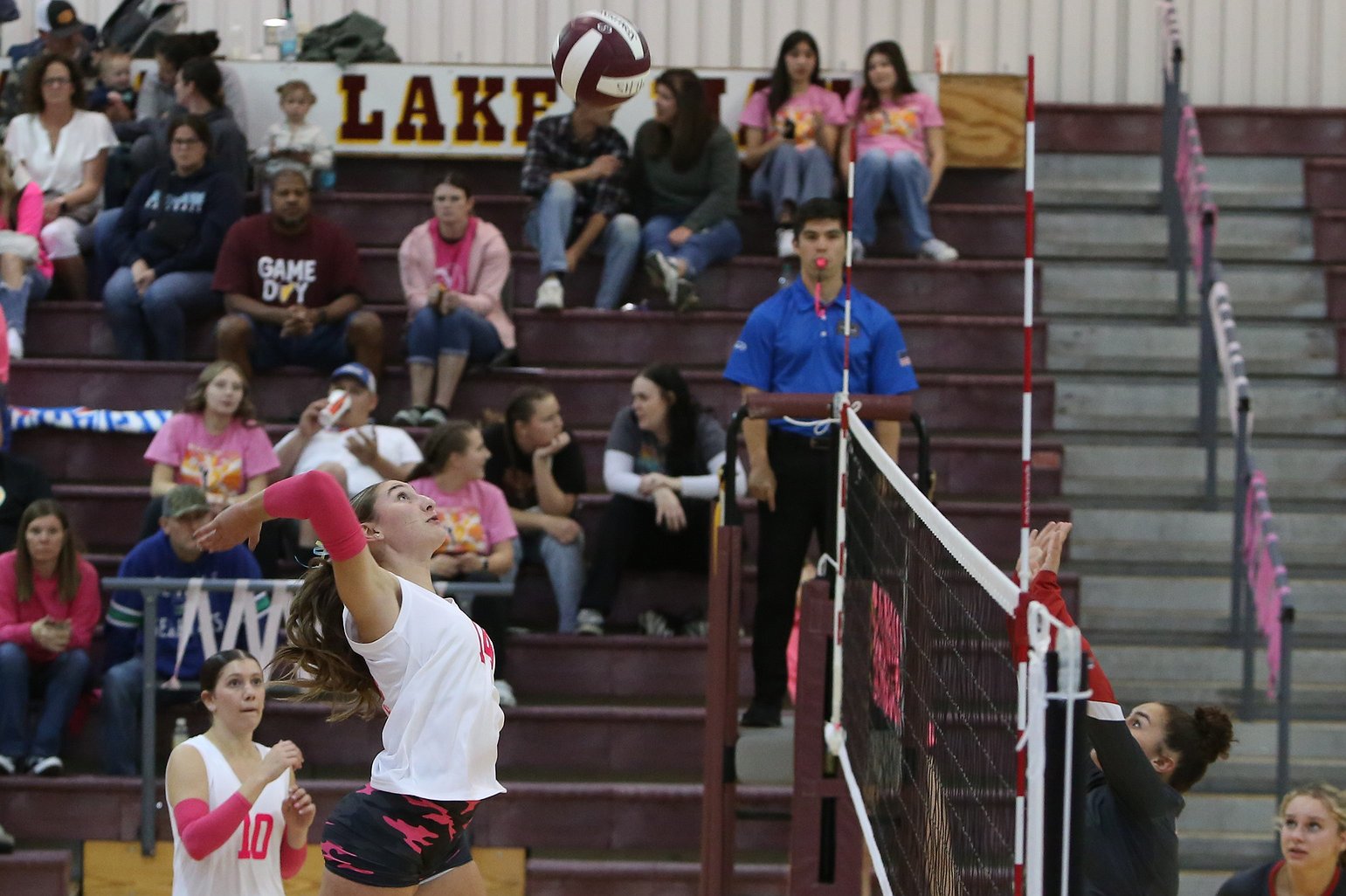 The Mavs’ Kardyn Martinez spikes the ball in their game against Sunnyside last season. Martinez has been All-League first team the last two seasons, and Trammell hopes to see that continue heading into her senior season this Fall.
The Mavs’ Kardyn Martinez spikes the ball in their game against Sunnyside last season. Martinez has been All-League first team the last two seasons, and Trammell hopes to see that continue heading into her senior season this Fall.Sports
A midseason review of San Diego FC’s inaugural run – The Daily Aztec
Before the start of the 2025 MLS season, pundits and analysts across the media had their fun with predictions, hot takes, and potential storylines ahead of the season. No one, however, could have predicted the early success of Major League Soccer’s newest member, San Diego FC. Like most expansion teams in American […]

Before the start of the 2025 MLS season, pundits and analysts across the media had their fun with predictions, hot takes, and potential storylines ahead of the season. No one, however, could have predicted the early success of Major League Soccer’s newest member, San Diego FC.
Like most expansion teams in American sports, predictions about SDFC’s inaugural season generally followed the assumption that they would struggle throughout the year, ending up near the bottom of the league and building up from there.
Yet the San Diego squad is not one to abide by precedent, as not even hometown media could have predicted this level of early success. With a 10-3-5 record and sitting alone at second place in the Western Conference, SDFC is not only poised for a successful inaugural run but also a potential inaugural playoff run that borders on title contention.
Expansion clubs in the MLS have found early success before, as seen most recently with St. Louis City SC, which finished first in the Western Conference in its 2023 inaugural season. This, however, is very much the exception rather than the norm.
To better understand this unexpected development and where it might all be heading, it is important to break down some key developments that occurred both before the start of the season and during.
Blooming culture
Team culture is the foundation of any professional sports club, and SDFC Head Coach Mikey Varas and his staff have built a bedrock that players have fully bought into and built on.
Varas speaks often of maintaining a growth mindset in the squad, not allowing complacency to creep in. He promotes playing with bravery, always looking for ways to improve, and remaining focused on the task at hand.
“Making sure our feet stay on the ground, making sure that we’re not getting too high or too low, and part of that is just remembering that our first and ultimate goal is to be fighting for playoffs in our first year,” Varas said during a media availability regarding the group’s biggest challenge.
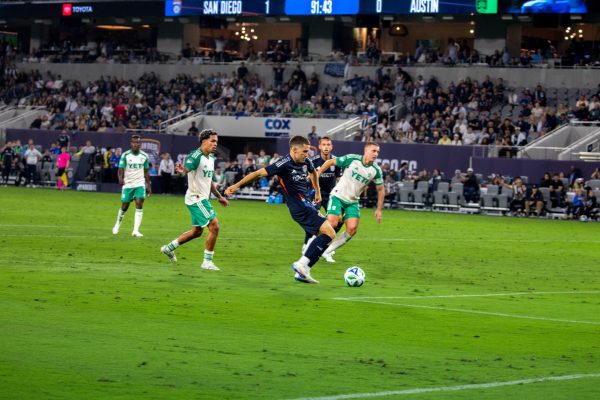
Underrated and hungry talent
Before San Diego’s inaugural season got underway, many of the players the team acquired were relative unknowns to the city. Outside of players named Hirving Lozano, you would be hard pressed to find someone outside of soccer fanatics who knew much about the squad.
When taking a closer look at this group, however, a fine collection of talent is revealed. Up and down the squad, players are making their mark not just on the team but on the league as well. Whether it’s Danish forward Anders Dreyer’s calculated offense and league-leading nine assists, team captain Jeppe Tverskov anchoring the midfield with veteran Aníbal Godoy, or supersub and Escondido native Milan Iloski putting his heart into every score off the bench.
The true depth of that talent will be put to the ultimate test over the course of the next few weeks, with many starters on the team missing due to injury or international duty.
Controlling the flow
Well before opening kickoff, Varas was clear in his desire to see his team play with relentless press and bravery on the ball against opponents. His squad heard him loud and clear, making SDFC’s offense in competition with some of the best in the league, holding a top 10 position in most attacking statistics.
Tied for first in the league in possession statistics, San Diego doesn’t let other teams dictate the game either, putting opponents on the back foot and forcing them to play uncomfortable and out of scheme.
Defensively, the squad has made incredible strides as well. After bouncing back from an abysmal April where the team allowed nine goals in four matches, the defense displayed real tenacity, stifling the opposition to allow only five goals in the last eight matches.
“That’s something we’ve been working on from day one, how we defend together,” defender Christopher McVey said of the improvement. “It’s a collective thing, a lot of times people think it’s just the defenders, but it’s a team effort, and I think we’ve been taking big steps in all of the positions, but especially up on the start of the press.”
With 16 matches to go, there is still plenty of gametime left and questions to be answered. Though barring a disastrous collapse, San Diego FC is well on its way to its first-ever postseason in its first-ever season.
As long as the squad remains consistent in their form, their destiny will remain in their own hands. With the supporters who have made Snapdragon Stadium a homefield bastion backing them, the sky is the limit for this young club.
Sports
The Secrets of Achieving Work-Life Balance
In today’s fast-paced world, achieving work-life balance is more crucial than ever, especially for those in high-demand careers such as hospitality, the culinary arts, and wellness. These industries require not only long hours and intense focus but also the ability to maintain physical and mental wellbeing to thrive. Without a healthy body and mind, the […]

In today’s fast-paced world, achieving work-life balance is more crucial than ever, especially for those in high-demand careers such as hospitality, the culinary arts, and wellness. These industries require not only long hours and intense focus but also the ability to maintain physical and mental wellbeing to thrive. Without a healthy body and mind, the challenges of leadership, creativity, and personal growth become even more difficult to navigate.
The benefits are well-documented – individuals who prioritise their health experience more energy, improved concentration, and greater overall satisfaction in both their personal and professional lives. Indeed, the most successful leaders recognise that their wellness is directly tied to their impact, and therefore it’s essential to foster habits that promote longevity, resilience, and clarity.
We spoke to five professionals who embody this philosophy, each offering unique insights into how they integrate wellness into their demanding careers. From the luxury hospitality sector and the culinary industry to nutrition, these individuals show how self care plays an integral role in achieving success.
Whether it’s through daily fitness routines, mindfulness practices, or conscious eating habits, these dynamic leaders demonstrate how maintaining personal wellness helps them navigate their roles with greater ease, focus, and satisfaction, ultimately benefiting their teams and those they serve.
Sander Looijen
General Manager at The Westin Resort Nusa Dua, Bali and Multi-Property Vice President – Bali (Premium & Select Properties) of Marriott
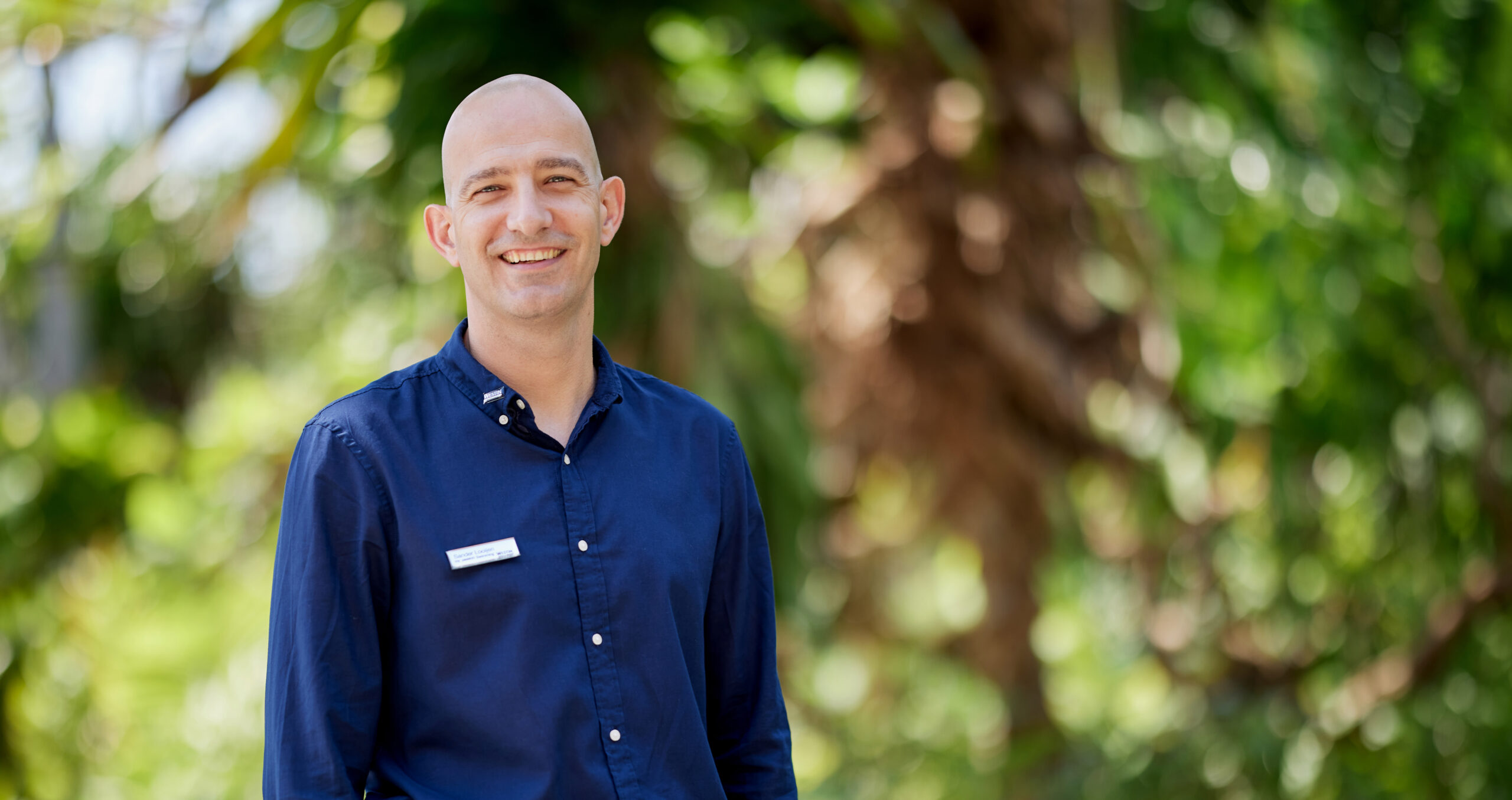
For the general manager of The Westin Resort Nusa Dua, Bali, staying active is crucial to both his wellbeing and leadership, especially when he’s performing a dual role as well.
“Staying active keeps me sane,” Sander Looijen shares, and even with his packed schedule, he makes time for swimming and water polo. Beyond fitness, Sander incorporates daily rituals such as meditation and journaling, recognising the importance of mental clarity in achieving work-life balance. “Wellness isn’t just about physical health, it’s about emotional balance,” he adds.
At the resort, wellness is about creating a holistic environment where multiple wellness experiences work in tandem. Guests can choose from yoga sessions, spa treatments, and nutritious meals, but the real benefit lies in how these elements layer together, helping guests reset and reconnect with themselves.
He highlights that wellness is integrated into every part of the experience, from the calming atmosphere on arrival to the personalised programs tailored to guests’ needs. Sander recommends exploring personalised wellness programs, which have proven to have a lasting impact on guests, ensuring they leave feeling rejuvenated, both physically and mentally.
Yuda Bustara
Chef and media figure, winner of Netflix’s The Maverick Academy
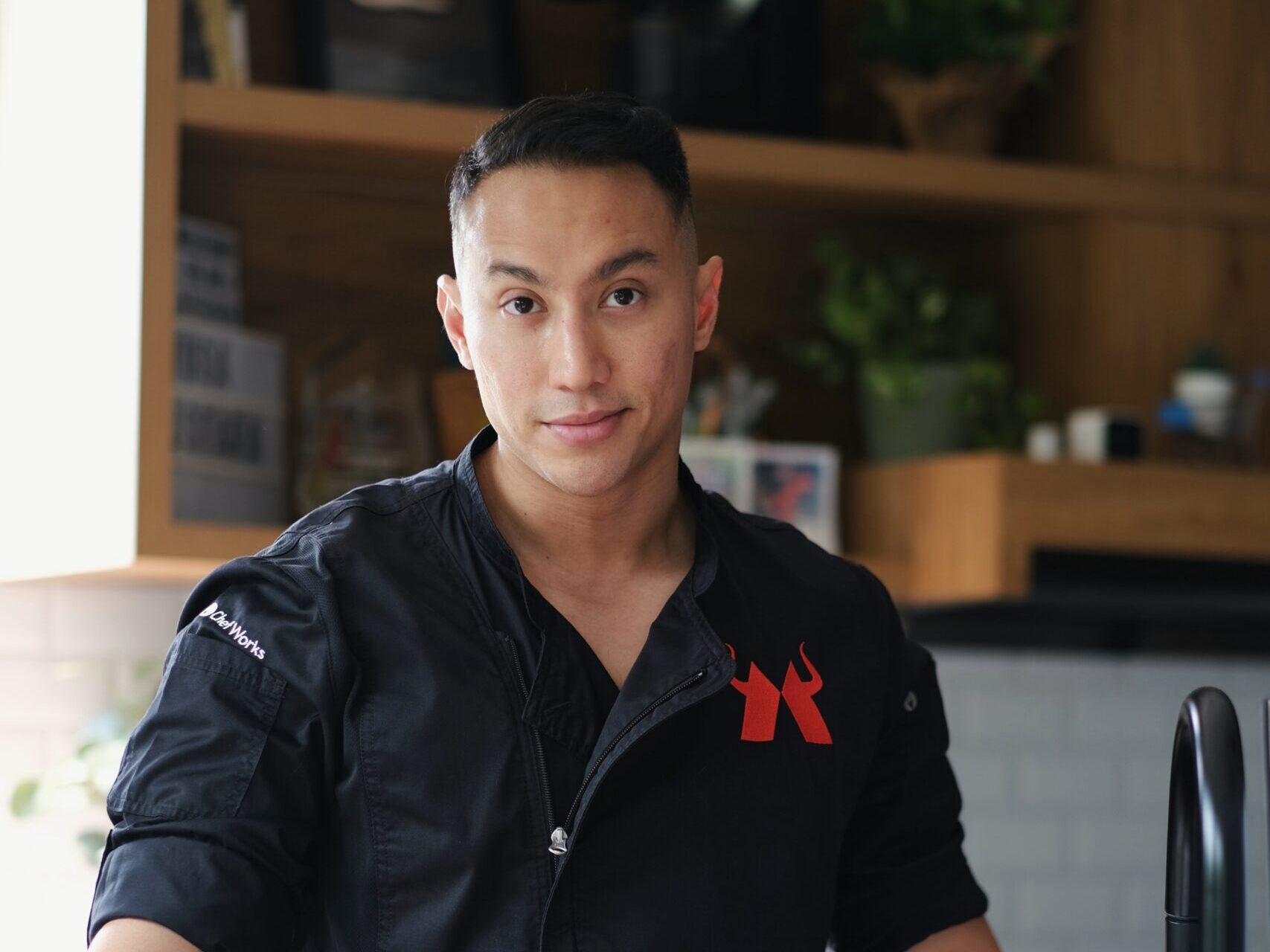
Chef Yuda Bustara approaches wellness with the same passion he applies to his career. Known for his boundless energy, he integrates weight training, cardio, and meditation into his routine. “It’s less about strict routines and more about making space for what keeps me energised,” Yuda explains.
When it comes to nutrition, he follows a balanced approach, opting for high-protein meals including ayam kecap and telur balado while indulging occasionally in favourites such as nasi Padang. Yuda believes that mental resilience is just as important as physical health. “You don’t have to choose – your health fuels your passion,” he advises, encouraging young chefs to find harmony between what drives them and their wellbeing.
For him, cooking is therapeutic, especially when preparing simple meals for himself away from the kitchen’s pressure. “Cooking at home, when no one is watching, helps me stay grounded,” Yuda reflects. With media appearances, brand work, and culinary projects often taking centre stage, he relies on tools such as Google Calendar to keep himself organised. He advises young chefs to take time for themselves and build wellness into their routine, ensuring they remain healthy both physically and mentally in an otherwise demanding industry.
Aulianty Fellina
Senior Director of Marketing Communications & PR at Sofitel Bali Nusa Dua Beach Resort
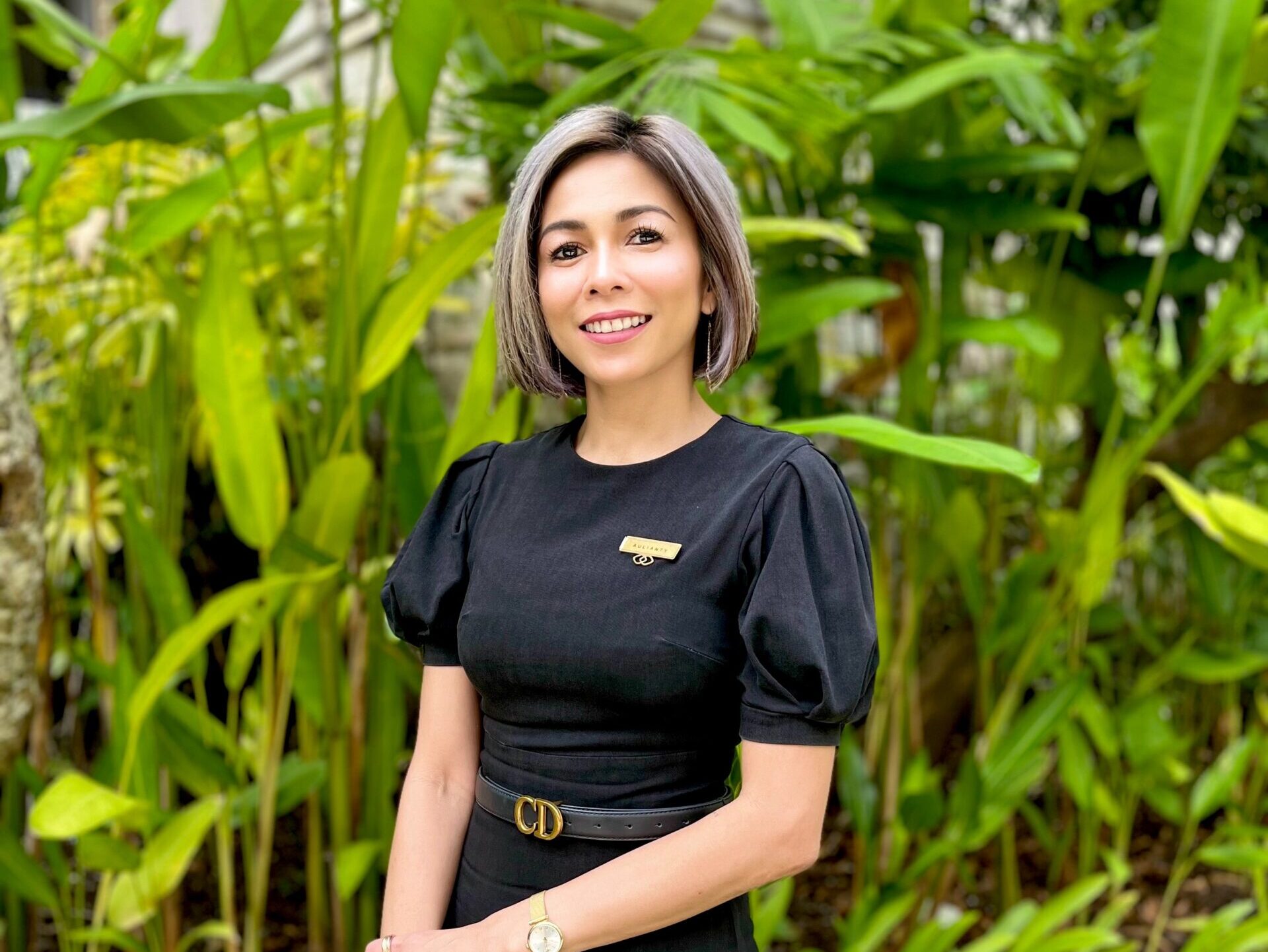
Aulianty Fellina knows that wellness is not a luxury, but a necessity, especially in a fast-paced, high-demand environment like the hospitality industry. Achieving work-life balance is key, and she’s rigorous in her approach to daily habits that help maintain both her physical and mental wellbeing.
Her mornings start with a calming walk, a ritual that helps reset her mind before the day’s responsibilities begin. She’s mindful of the need for mental clarity, which she achieves by stepping away from screens, enjoying a proper coffee, and taking time for quiet moments of reflection. Her approach to wellness revolves around small but essential routines.
Physical movement is a non-negotiable for Aulianty, whether it’s a morning walk or a session at the gym, setting the tone for the day. She also values mindful eating, prioritising fresh, local ingredients, and makes time to truly enjoy her meals. When it comes to rest, sleep is treated as a priority; Aulianty ensures she gets at least eight hours each night, understanding that adequate rest is essential for staying sharp and grounded in her demanding role.
Her morning ritual helps her prepare for high-pressure moments, especially when juggling the demands of her career. Her daily routine includes walking her dogs, stretching, and having a quiet coffee to set her intentions for the day.
At Sofitel Bali Nusa Dua, wellness is deeply embedded in the guest experience. Aulianty encourages guests to embrace sunrise yoga and soothing spa treatments, both of which are woven into the resort’s holistic approach to wellness. “We’re creating a space where people can reset and feel like themselves again,” she says.
dr. Ayu Diandra Sari, MM, M.Gizi, Sp.GK
Clinical nutritionist and media figure, former beauty pageant titleholder of Puteri Indonesia Lingkungan (Miss Indonesia Environment)

Clinical nutritionist dr Ayu Diandra Sari advocates a personalised approach to health. “A healthy relationship with food starts with understanding your body,” she explains, emphasising the importance of evidence-based nutrition.
She encourages people to tune into their hunger and fullness cues, choose whole foods, and align their meal times with their daily activities. This foundation helps individuals avoid falling prey to fad diets, fostering a sustainable approach to eating that encourages long-term health and achieving work-life balance.
For dr Diandra, wellness is a balance of nutrition, exercise, and mental wellbeing. Her morning begins with self-reflection and a high-protein, fibre-rich breakfast to fuel her body for the day ahead. She believes in the power of regular exercise, incorporating swimming and power walking into her weekly routine.
To manage stress, she also practices meditation and deep breathing exercises. Despite her busy schedule, she recognises the importance of quality sleep, aiming for six to eight hours of rest each night to ensure her body and mind recover fully.
When it comes to nutrition, she sees athletes as an ideal example of discipline and consistency. She encourages non-athletes to adopt the same principles, focusing on food quality, hydration, and meal timing. “It’s all about consistency,” she says, noting that athletes’ discipline can teach us valuable lessons about nutrition. Small, gradual shifts, such as increasing vegetable and fruit intake, prioritising sleep, and engaging in physical activity, can significantly improve overall wellbeing.
Rahma Susanti
Director of Wellness Pre-Operations of The Meru Sanur
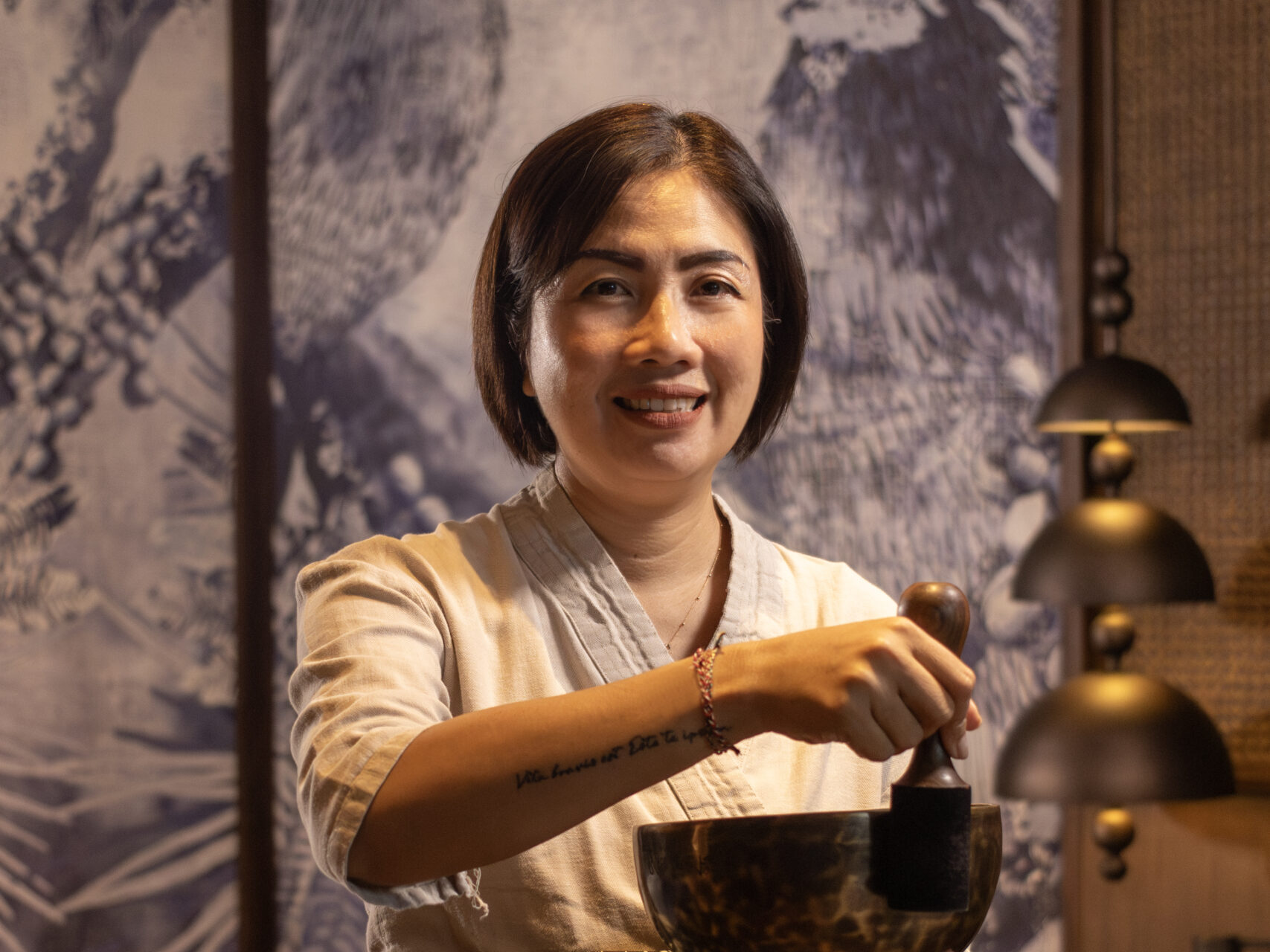
At The Meru Sanur, Rahma Susanti focuses on creating transformative wellness experiences through a balance of ancient Balinese healing traditions and modern wellness practices.
“Wellness is about finding balance, not just within yourself, but also with the world around you,” Rahma explains. Her approach as the resort’s director of wellness pre-operations is rooted in Bali’s Tri Hita Karana philosophy, integrating elements such as grounding rituals and energy healing.
Each guest’s wellness journey is personalised, guided by their Weton birth calendar, to ensure a deeply meaningful experience. Rahma’s own daily routine includes a simple but grounding morning ritual, starting with deep breathing and an affirmation: “Om Awignam Astu Ya Namah Swaha,” which translates to “May everything unfold with kindness.”
This practice, paired with calming music, helps her stay balanced and focused throughout her demanding day.
Looking forward, Rahma is excited to introduce a Wellness Botanical Garden at The Meru Sanur, which will offer guests an immersive, eco-friendly space for healing and connection to nature. “Small wellness habits like mindful breathing can make a huge difference in your life,” she adds, encouraging others to incorporate this practice into their daily routines. For Rahma, wellness is about relaxation as well as creating lasting, meaningful change.
Sports
‘People will say wow!’ Wellsville’s Kaylee Oswald wins third New York State track and field championship
Senior heading to Western Michigan University on track and field scholarship, raised the bar for future generations of athletes By JOHN ANDERSON A strange noise echoed through the school hallways in Wellsville, a loud thud with a metallic edge to it. Members of the custodial staff never looked up as they cleaned the combination of dirt, […]

Senior heading to Western Michigan University on track and field scholarship, raised the bar for future generations of athletes
By JOHN ANDERSON
A strange noise echoed through the school hallways in Wellsville, a loud thud with a metallic edge to it. Members of the custodial staff never looked up as they cleaned the combination of dirt, mud and sand and salt from snow off the floors on this early December day.
The echo continued down toward the music rooms where Jeff Joslyn is giving music lessons after school. He continues on as if the sound was a metronome.
Everyone was used to it.
The sound was coming from the small, middle school gym. Two sets of bleachers on one side. Too small for a big athletic contest, but just the right size for Kaylee Oswald to throw an indoor-specific discus and a shot put.
Oswald peers out of the gym and sees two of her teammates, both underclassmen, and instructs them to get warmed up and starts going over how to throw. She sounded like a veteran coach. She is not. She’s a senior at Wellsville training to win an unprecedented third state championship in the shot put.
Maybe this was on purpose, but Oswald could have trained upstairs in the high school gym where close to 100 Section V championship banners hang and two with her name on them for winning states. Instead, she was in the gym with bare walls, no shadows of past wins, just a place you have to prove yourself.

Over the weekend, she solidified herself as a champion. At Middletown High School, Oswald threw the shot put 40-4.50 to win a third straight New York State Championship.
She also qualified for states in discus and of all the athletes at the state meet from Section V, she was awarded the overall Section V Sportsmanship Award winner at the state championships as well.
Dean Giopulos, who has coached the boys’ track team at Wellsville for years, but started as a girls’ assistant 41 years ago, looked around and said, “I would say she’s had a very, very good day today.”
With Kaylee winning and competing in two events, Xavier Scott winning states in the hurdles and J.J. Howard taking third in the high jump and competing in the long jump, Giopulos said, “They set marks people will look at and say, ‘Wow.’ Our record board compared to other schools has always been good, but now it’s amazing.”

But that’s not all. Oswald has several Section V swimming championships including winning the 100 backstroke and her finish in the 50 free. Giopulos does not remember another athlete decorated with this many individual championships.
THE DECISION
This fall, Oswald will be attending Western Michigan University in Kalamazoo on a track and field scholarship. Western Michigan University won the Kaylee Sweepstakes after official visits to University of Connecticut, Kent State, Elon University and University at Buffalo.
“Their coach reached out, I liked the coach and I liked the program,” Kaylee said. “They have a good scientific-based program that I think would benefit me in the future.
It will be a different approach to throwing, I’ll have a coach in the weight room, it will make me a better athlete and a better thrower, so I am super optimistic about all of it,” she added.
PROUD AS A COACH
Larry Peacock, the new Wellsville Girls’ Track and Field coach, is impressed with his star athlete.
“To win states, it had to be her best throws for the day and that’s what she did. It got her the win,” said Peacock. “She’s glue, that’s what she is to us and this program. She leads by example. Everyone follows, her presence makes her better and that’s going to be a loss,” Peacock said. “She is a consummate teacher, always helping the other kids throwing. You see it on the bus rides, you see it on the track, when she shows up, everything is good. When she shows up, she’s a calming influence. She doesn’t flinch. It’s made the younger kids get better.”

What others didn’t see was the rest of the state training to beat her.
Giopolus said, “I don’t know if she would ever admit this, but for the last two years she’s been hunted. Everyone aims for her, everyone wants to knock her off and she doesn’t show the pressure. She goes out there and seems to get better. All the sectional titles she has won — and she is the only multiple winner of state championships in the school — I can not imagine anyone winning three in a row again. You never say never, but the chances of someone doing that again are unimaginable.”
Peacock said the state has also recognized her as a champion.

“Look what she has earned — the 2025 state champion board, and most of all, she got the sportsmanship award. Here you are, you practice like a champion and you perform like a champion and act like a champion. Period. That’s what she does, that’s what she did,” Peacock said. “Her action of teamwork, practice, and results … she builds on it. I’ve seen a lot of athletes, and I don’t think we’ll see an athlete coming out of Wellsville like this in a long time. She’s won sectionals in swimming, track, state titles … if there’s something she wants to do, she will do it. She has the work ethic. She will definitely flourish in college.”
STAYING MOTIVATED
What keeps Kaylee motivated? It was simple. Another title.
“To do it again, I strived to do better than the past,” she said. “To get better as a senior, I had to put a lot of time in the weight room and I’m doing more technical throwing. Last year, I took the power I had and turned it into a throw. Now, I am taking everything and putting it into a throw. So this year when I popped one, it went further.”
YOUTH SERVED
Oswald didn’t wake up in 10th grade and become a state champion. She worked at other sports to become an athlete who has power and incredible athletic ability and agility. She did seven years of gymnastics with G2 Gymnastics & Fitness in Shinglehouse, Pa., and was a swimmer.
When the COVID pandemic hit, she kept working.
“In eight grade during Covid, my sister, Stephanie Oswald, was also a thrower and we would practice on the road in front of our house,” Oswald said.
Her sister also had a throwing coach, George Kinnicutt, who had a pretty good track record with Wellsville sectional champions and coached his daughter, Emma, to a state title as well.
“She kept going and worked with George, then I went and worked with George and it kind of snowballed,” Oswald said. She lifted at the school and when that was closed, she lifted at JB’s Family Fitness.

After a long day or school and a long practice, Oswald would put in another throwing session with Kinnicutt to continue to improve and cement her state championship resume.
“I realized three of our state champions were throwers (Sue Livergood also won states), so I put faith in George,” Kaylee said. “I had the confidence that he was an amazing coach and would get me to my fullest potential. Working with him and having him by my side would give me the best chance to win states.”

Suddenly, shot put was an event she fell in love with.
“I think I liked the fresh start from gymnastics. This was all new. It was technical like gymnastics, but not in your face, it was at my pace. And, I could see quick improvements, so it was easy to fall in love with,” Oswald said. “My freshman year, I was competing in the discus. By my sophomore year, I had won states in shot put and made the state qualifier in discus.”
And then a great junior year at states.
To do them both was not a concern.
“Most of the time shot put is first. If discus is first, I’ll put 100 percent effort, but make sure I have energy to throw shot and I do not get discouraged if I do not do well in discus,” she said of her strategy during her career.
THE FIRST TITLE
She will never forget that first state title.
As a sophomore, she threw 37-10 to nip Maine-Enwell’s Panayiota Anastos by a fraction of an inch, who threw 37-9.75.
“I don’t think that it helped that I won by a quarter of an inch, I did not expect it,” Oswald recalls. “It took three days to sink in that I won.”
Followed by a lonely fire truck celebration ride.
“It was weird having all the attention, I felt there was too much attention on me,” she said. “Usually it’s on a sports team that wins, so it was weird having it focused just on me.”
WORKING HARD AND FAMILY
Oswald said there is no secret.
“I practice every day. When it’s nice out, I’m outside in Wellsville or Bolivar or at the circle that’s at my house. And I am lifting four days a week on top of it. When the weather is bad, I’m in a school or the Alfred State College gym, in my house, outside my house,” she said. “And I’m working with our younger throwers, Makenna Cooke and Sarah Mattison, coaching them up.”
Her parents have enjoyed the success, and they have put the miles on the vehicle to see it.

“My parents (Jim and Katie Oswald) are always at every single meet, they have been very good to me,” she said. “They take me to nationals each season, they took me to Boston for indoor, Philadelphia for nationals for outdoor. For states, we go from Staten Island to Middletown.”
WHATS NEXT
Her college throwing coach at WMU will be Kayleigh Conlon, and Oswald has already been instructed to hit certain marks.
“The ultimate goal is 50 feet in shot put and a lot of records personal-wise,” she said.
To throw in the Olympics, you have to throw over 60 feet. Is that attainable? She’s gained five feet each season.
“Yes, but I don’t know how long that will last. I think it will last through this year,” she said. “The only thing I am trying to gain from college is new coaching and getting better. I love the sport too much to turn it into a job because then it would discourage me.”
And speaking of jobs, many student-athletes in the BOCES New Visions Medical Program have to drop a sport or sports altogether because of the demand of classes. Oswald made it part of her routine.
“In the New Visions Medical Program. I really liked studying this year and it was a very tough class,” she said. “By the time I am done practicing and lifting, I study. But I’ve learned to love cooking and meal prep.”
Giopulos said it’s more than that.
“Her story is not just how she has developed as an athlete, she’s also matured so much as a person,” he said. “She is fun to be around and she has earned every bit of it.”

New York State Class C Championship Girls ‘ Shot Put Results
1 Kaylee Oswald Wellsville – C [12] 40-4.50
2 Grace Walley Walton-C [10] 40-0.75
3 Hannah Roggie Beaver River-C [11] 39-5.00
4 Desiree Jean-Pierre Saranac-C [12] 38-8.00
5 Nora Tighe Pulaski-C [12] 38-5.25
6 Nyla Wilson-Epps Tapestry Charter-C [12] 37-1.00
7 Lauren Paske Chenango Forks-C [12] 36-8.25
8 Jernessa Donaldson Solvay-C [10] 36–03.75
9 Maggie Hawken Campbell-Savona-C [10] 35-2.00
10 Danae Morgan Hastings-C [11] 35-1.25
11 Mikayla Johnson Southwestern-C [11] 34-11.75
12 Nola Bohringer Cobleskill-Richmondville-C [11] 34-7.50
13 Kaitlyn Putman Madrid-Waddington-C [12] 34-7.25
14 Sadie Konjas Onteora-C [11] 31-11.75
15 Mehana Levy Port Jefferson-C [11] 30-2.00
16 Krysta Wheeler Monsignor Scanlan-C [11] 28-11.00
17 Olivia Garcia Oyster Bay-C [12] 28-8.00
18 Rebecca Pepin Riverdale Country Day-C [11] 26–07.50

Sports
Western volleyball adds five players and new assistant coach
Western Washington University’s volleyball team announced Justice Magraw has joined the staff as the lead assistant coach for the 2025-26 season. Magraw began her new position on Monday, June 9. “Taking the role as the assistant coach at Western Washington is a step toward living out my values and expanding who I am and what […]
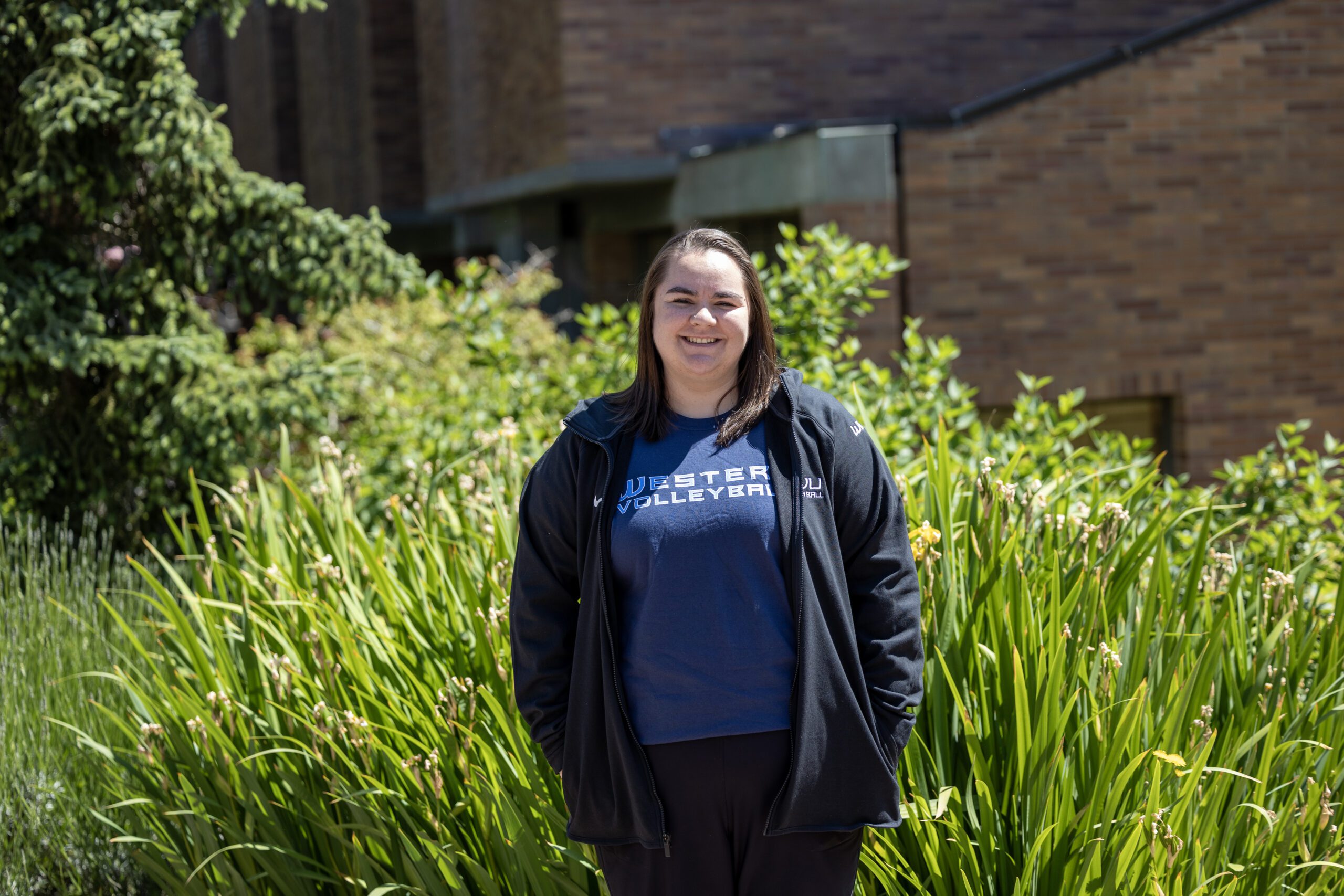
Western Washington University’s volleyball team announced Justice Magraw has joined the staff as the lead assistant coach for the 2025-26 season. Magraw began her new position on Monday, June 9.
“Taking the role as the assistant coach at Western Washington is a step toward living out my values and expanding who I am and what kind of coach I want to be,” Magraw said in a news release on June 12. “The dedication and ownership I’ve already witnessed from the players and alumni are truly remarkable, and I’m particularly excited to contribute to this special culture.”
Magraw, a Redmond native, joins Western after four years as an assistant coach for the University of Washington. Magraw also played for the Huskies from 2012-15, earning four varsity letters and four consecutive trips to the NCAA tournament with a combined record of 117-16.
“I could not be more excited to have Justice joining our WWU family and the volleyball program as an assistant coach,” Western head coach Diane Flick-Williams said in the release. “She brings a variety of experiences, a wealth of knowledge and an energy that is infectious.”
Magraw joins five other Washington natives to complete the 2025 volleyball roster. The 2025 recruiting class includes middle blocker Brooke Berglund, outside hitter Aly Skagen, PIN hitter Maren Stuber and defensive specialist Dani Turcinec.
“I am really excited about this 2025 group coming in,” Flick Williams said in a February release. “It is not just about what they can bring to the play of the game, but what they can bring to Viking Volleyball culture.”
Vikings’ softball standout Maleah Andrews will also be joining the roster for the 2025 season while continuing to compete with the softball team in the spring. She will be a setter for the Vikings.
Nick Zeller-Singh is CDN’s sports reporter; reach him at nickzellersingh@cascadiadaily.com; 360-922-3090 ext. 104.
Sports
Track & Field: Appleton’s runner-up finish highlights final day in Eugene : Jerry Ratcliffe
Courtesy UVA Media Relations Photo: UVA Athletics The Virginia women’s track and field team closed out competition at the NCAA Outdoor Championships at Hayward Field in Eugene, Ore., on Saturday. Margot Appleton finished runner-up in the women’s 1500-meters while Celia Rifaterra and Estel Valeanu notched All-America honors in the high jump and discus throw. APPLETON […]
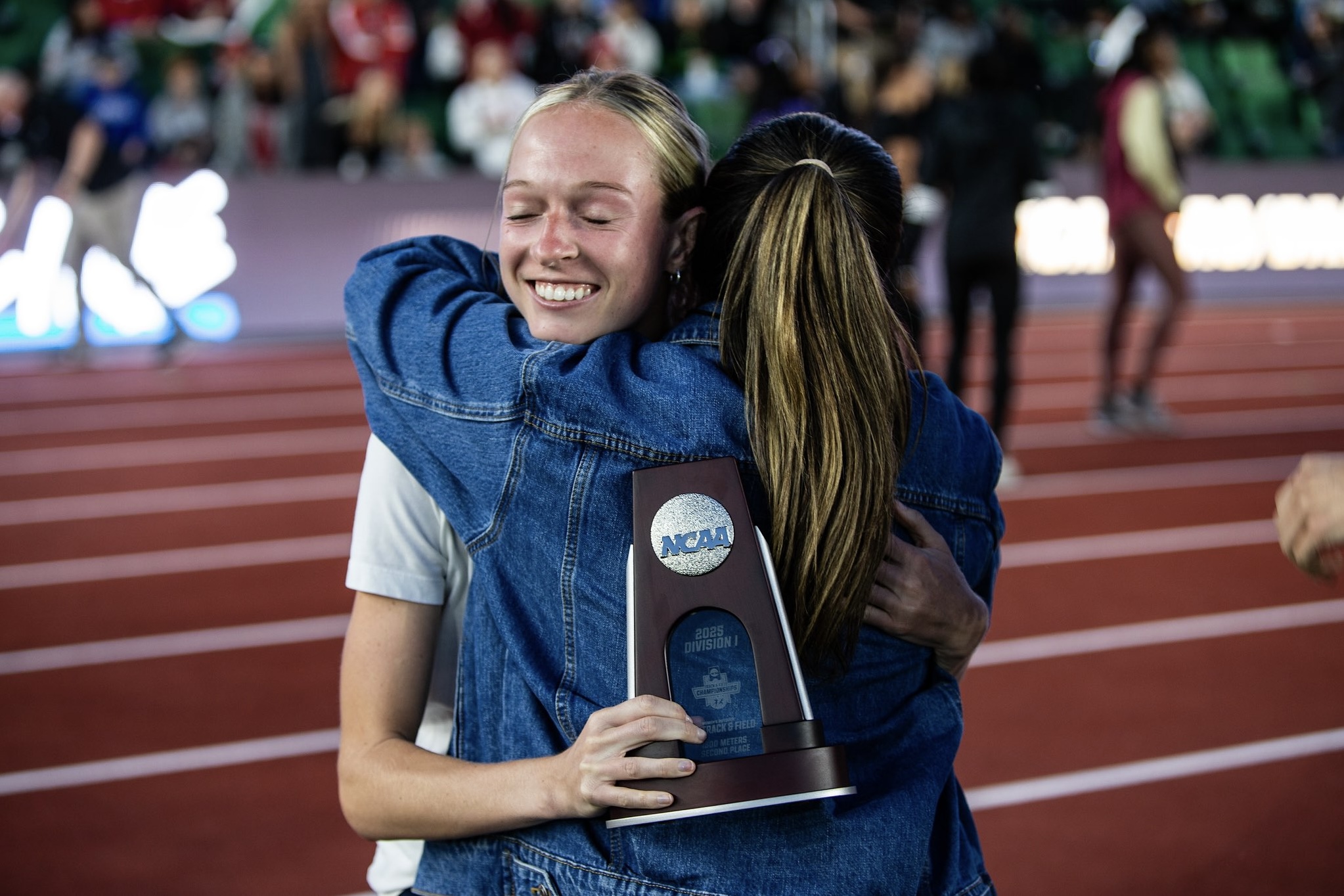
Courtesy UVA Media Relations
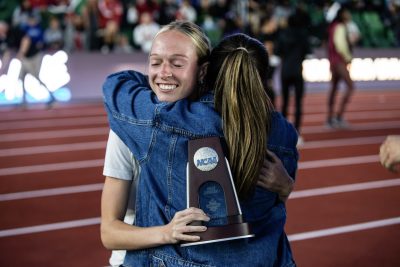
Photo: UVA Athletics
The Virginia women’s track and field team closed out competition at the NCAA Outdoor Championships at Hayward Field in Eugene, Ore., on Saturday. Margot Appleton finished runner-up in the women’s 1500-meters while Celia Rifaterra and Estel Valeanu notched All-America honors in the high jump and discus throw.
APPLETON RETURNS TO THE PODIUM
In her third NCAA Outdoor Championships appearance, Margot Appleton completed the 1500-meter and 5000-meter double, earning All-America honors in both events.
-
Appleton executed a tactical race in the women’s 1500-meters to become the NCAA runner-up clocking 4:08.99 and earned first team All-America honors.
-
This marks the second time in three years in which Appleton has made the podium in the women’s 1500-meters at the NCAA Outdoor meet. She finished third in the event in 2023.
-
Just under two hours later, Appleton toed the line in the women’s 5000-meters where she finished 13th, clocking 15:44.76.
-
For her performance in the 5k, the senior earned second team All-America accolades.
-
This marks her second consecutive year earning All-America honors in the 5000-meter event after finishing fourth a year ago.
ALL-AMERICA HONORS FOR VALEANU
In her third consecutive NCAA Outdoor Championships, Estel Valeanu earned second-team All-America accolades in the women’s discus.
-
On her first throw in the competition, Valeanu recorded a new personal best of 58.22m/191-0 to finish ninth in the field.
-
Valeanu bettered her previous best of 57.28m/187-11 and improved her Virginia No. 2 all-time mark.
-
She adds another All-America accolade to her resume alongside a ninth in 2024 competing for LSU and sixth in 2023 with Harvard.
RIFATERRA SETTING THE BAR
In her second NCAA Outdoor Championship appearance, Celia Rifaterra cleared 1.84m/6-0.5 to finish seventh in the high jump and earn first team All-American honors.
-
After earning honorable mention honors a year ago, Rifaterra notched first team All-America honors clearing 1.84m/6-0.5 for seventh place.
-
Rifaterra cleared the first three bars on her first attempt at each height before knocking the bar down at 1.87m/6-1.50.
-
Alongside Rifaterra was her teammate, Carly Tarentino in her NCAA Outdoor Championships debut. Tarentino cleared 1.74m/5-8.50 on her first attempt to finish tied for 19th place and garner honorable mention accolades.
WEDNESDAY-FRIDAY RECAP
-
Gary Martin finished fifth in the men’s 1500-meters to earn his first career outdoor first team All-America accolades, clocking 3:47.58.
-
In the men’s 5000-meters, Will Daley execute a smart race to earn his first second team All-America honors, finishing 13th in 13:36.55. He moves up to No. 5 all-time in program history.
-
On the first day of competition, Keyandre Davis garnered second team All-America honors in the men’s hammer, throwing for 66.24m/217-4 to finish 15th in the field of 24 athletes.
-
On the second day of competition, Annika Kelly secured second team All-America honors in the women’s hammer, throwing for 64.87m/212-10 to finish 14th in the field.
-
In the semifinal, Gary Martin (3:52.97) and Margot Appleton punched their tickets to the final in the men’s and women’s 1500-meters. Both earned an automatic bid, placing in the top five finishers in their respective heats.
-
In their NCAA Outdoor Championships debut, Alex Sherman (50.98) and Jenny Schilling (33:07.58) notched honorable mention accolades in the men’s 400-meter hurdles and the women’s 10,000-meters. Both finished 17th in the competition.
-
Justin Wachtel garnered honorable mention accolades in the men’s 5000-meters.
Scoring a total of 10 points, the Virginia women finished 26th in the team standings.
2025 CAVALIER ALL-AMERICANS
First Team: Margot Appleton (1500m), Gary Martin (1500m), Celia Rifaterra (High Jump)
Second Team: Margot Appleton (5000m), Will Daley (5000m) Keyandre Davis (HT), Annika Kelly (HT), Estel Valeanu (Discus)
Honorable Mention: Alex Sherman (400mH), Jenny Schilling (10,000m), Carly Tarentino (High Jump), Justin Wachtel (5000m)
-

 College Sports2 weeks ago
College Sports2 weeks agoIU basketball recruiting
-

 Health2 weeks ago
Health2 weeks agoOregon track star wages legal battle against trans athlete policy after medal ceremony protest
-

 Professional Sports2 weeks ago
Professional Sports2 weeks ago'I asked Anderson privately'… UFC legend retells secret sparring session between Jon Jones …
-

 Professional Sports2 weeks ago
Professional Sports2 weeks agoUFC 316 star storms out of Media Day when asked about bitter feud with Rampage Jackson
-

 Rec Sports3 weeks ago
Rec Sports3 weeks agoScott Barker named to lead CCS basketball • SSentinel.com
-

 Rec Sports3 weeks ago
Rec Sports3 weeks agoJ.W. Craft: Investing in Community Through Sports
-

 Motorsports3 weeks ago
Motorsports3 weeks agoNASCAR Penalty Report: Charlotte Motor Speedway (May 2025)
-

 Motorsports3 weeks ago
Motorsports3 weeks agoRockingham Speedway listed for sale after NASCAR return
-

 College Sports3 weeks ago
College Sports3 weeks agoOlympic gymnastics champion Mary Lou Retton facing DUI charge
-

 Rec Sports2 weeks ago
Rec Sports2 weeks ago2x NBA All-Star Reacts to Viral LeBron James Statement






























